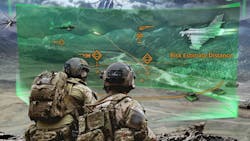U.S. Army investigates making night-vision goggles double as virtual reality and augmented reality devices
FORT BELVOIR, Va. – U.S. Army researchers are looking for companies able to write software that would enable digital night-vision goggles to enhance warfighter augmented and virtual reality capabilities on the battlefield.
Officials of the Army Contracting Command-Belvoir Division at Fort Belvoir, Va., issued a request for information (000128456) on Friday for the Fully Digital Soldier Architecture (FDSA) project.
This architecture should use high-frame-rate digital image feeds; 2-D and 3-D terrain data; and full-color displays to provide a more intuitive and ergonomic augmented reality interface, and a more realistic virtual reality experience.
Augmented reality adds digital elements to a live view, while virtual reality involves a complete immersion experience that shuts out the physical world -- useful for infantry simulation and mission rehearsal.
Related: Army researchers set sights on multispectral night-vision sensors for situational awareness
The Army Contracting Command is issuing this market survey on behalf of the Army Combat Capability Development Command (CCDC) Command, Control, Computers, Communications, Cyber, Intelligence, Surveillance, and Reconnaissance (C5ISR) Night Vision and Electronic Sensors Directorate (NVESD) at Fort Belvoir.
Fully digital soldier architecture software would be for the Army's Special Products and Prototyping Division (SPPD) Quick Response Branch (QRB), in partnership with the U.S. Special Operations Command and Program Manager Soldiers, Sensors, and Lasers.
The fully digital soldier architecture seeks augmented and virtual reality in night-vision goggles by combining a digital visual augmentation system; tactical assault kit-enabled end user device; tactical radio; weapon sights; and small unmanned aerial vehicles to provide capabilities not possible with analog systems, researchers say.
The Army particularly is interested in an architecture that has digital image processing to improve image quality, as well as an intelligent toggling system to modulate power and dataflow to save power and display only relevant information.
FDSA should allow individual users to customize their digital network, based on both their preferences as well as mission requirements. Customizable facets of the system should include degree of automation, end-state priority (up-time, detection, recognition, etc), and pieces of kit that constitute the network.
Hardware in the architecture must communicate via a hard-wired connection like USB 2.0, with options for wireless operation via Bluetooth, 802.11g, Wireless Personal Area Network (WPAN), or Ultra Wide Band (UWB). The radio shall be either wave relay radio such as an MPU-5 or wideband waveform such as a Harris 152A/163.
Prototypes may not be fully functional if they adequately demonstrate ways to enhance performance of the user and the system.
Related: Army reaches out to industry for ideas on augmented-reality training
This project will address four basic questions: can 3-D technology improve the infantry warfighter's performance and ability to take-in visual information; does the presence of a near-eye full-color digital display enhance user experience of augmented and virtual reality; can power throttling significantly enhance system up-time; and can distribution of processing improve system performance?
Companies interested should email 10-page white papers in .pdf form no later than 14 Nov. 2019 to the Army Contracting Officer Joanna Jones at [email protected].
Email questions or concerns to Joanna Jones at [email protected]. More information is online at https://www.fbo.gov/notices/095e8d8501715d780e267d2342b7389b.

John Keller | Editor-in-Chief
John Keller is the Editor-in-Chief, Military & Aerospace Electronics Magazine--provides extensive coverage and analysis of enabling electronics and optoelectronic technologies in military, space and commercial aviation applications. John has been a member of the Military & Aerospace Electronics staff since 1989 and chief editor since 1995.

